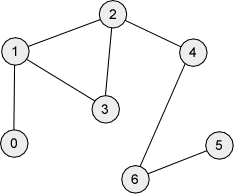
以该图为参考,假设我想找出从0到5的最长路径。
那么这条路径是:0->1->3->2->4->6->5
有没有好的算法可以解决这个问题?我已经搜索过了,但没有找到我能够理解的算法。我找到了很多关于最短路径(0->1->2->4->6->5)的算法,并且已经成功地实现了它们。也许是我自己的问题,但我希望不是这样 :)
任何帮助都将受到欢迎。

以该图为参考,假设我想找出从0到5的最长路径。
那么这条路径是:0->1->3->2->4->6->5
有没有好的算法可以解决这个问题?我已经搜索过了,但没有找到我能够理解的算法。我找到了很多关于最短路径(0->1->2->4->6->5)的算法,并且已经成功地实现了它们。也许是我自己的问题,但我希望不是这样 :)
任何帮助都将受到欢迎。
f = array of (2 ^ n) * n size filled with false values
f(1 << start, start) = true
for mask = 0 ... (1 << n) - 1:
for last = 0 ... n - 1:
for new = 0 ... n - 1:
if there is an edge between last and new and mask & (1 << new) == 0:
f(mask | (1 << new), new) |= f(mask, last)
res = 0
for mask = 0 ... (1 << n) - 1:
if f(mask, end):
res = max(res, countBits(mask))
return res
关于从哈密顿路径问题到这个问题的约简,我再多说一点:
def hamiltonianPathExists():
found = false
for i = 0 ... n - 1:
for j = 0 ... n - 1:
if i != j:
path = getLongestPath(i, j) // calls a function that solves this problem
if length(path) == n:
found = true
return found
/**
* Finds the longest path between two specified vertices in a specified graph.
* @param from The start vertex.
* @param to The end vertex.
* @param graph The graph represented as an adjacency matrix.
* @return The length of the longest path between from and to.
*/
public int getLongestPath(int from, int to, boolean[][] graph) {
int n = graph.length;
boolean[][] hasPath = new boolean[1 << n][n];
hasPath[1 << from][from] = true;
for (int mask = 0; mask < (1 << n); mask++)
for (int last = 0; last < n; last++)
for (int curr = 0; curr < n; curr++)
if (graph[last][curr] && (mask & (1 << curr)) == 0)
hasPath[mask | (1 << curr)][curr] |= hasPath[mask][last];
int result = 0;
for (int mask = 0; mask < (1 << n); mask++)
if (hasPath[mask][to])
result = Math.max(result, Integer.bitCount(mask));
return result;
}